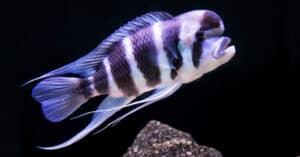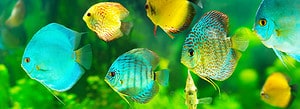Blue fish are unique and special-looking since blue is found in nature much more rarely than other colors. In fact, some cultures cannot even “see” blue—meaning that they cannot easily differentiate it from green!
This fascinating color palette also belongs to some incredible species, as you’ll see here on our list of the top 12 blue fish!

1. Betta
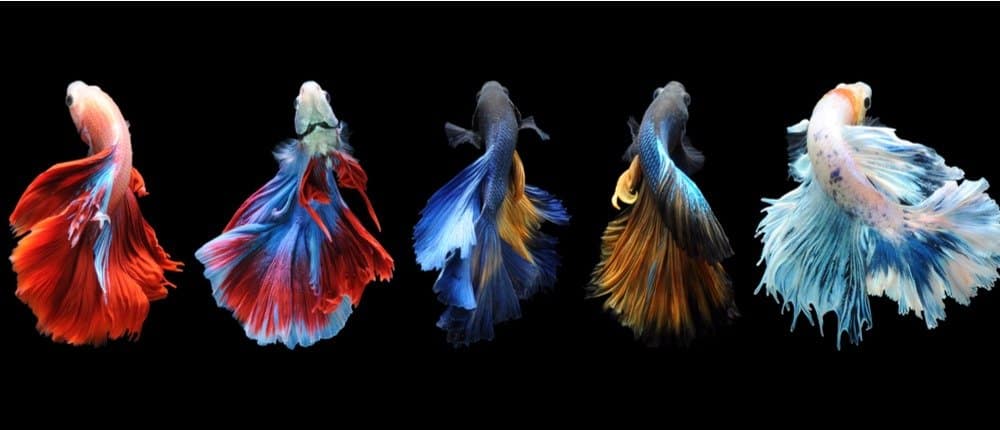
Betta fish come in many shades but are often blue
©Arif Supriyadi/Shutterstock.com
Betta fish are incredibly popular, mostly for their ability to live as sole fish in small tanks. However, many people underestimate the tank size they need.
Bettas should ideally live alone without tank mates, and especially not with other betta fish as they can be very aggressive. Their minimum tank size is 10 gallons.
Another reason bettas are so popular is their bright, vivid colors. When a betta is poorly cared for, it might be pale and discolored—then, as they live in proper conditions, they brighten right up.
The before and after photos of adopted bettas are amazing to see!
Betta fish come in many colors including steel blue, royal blue, and turquoise blue.
2. Cichlid
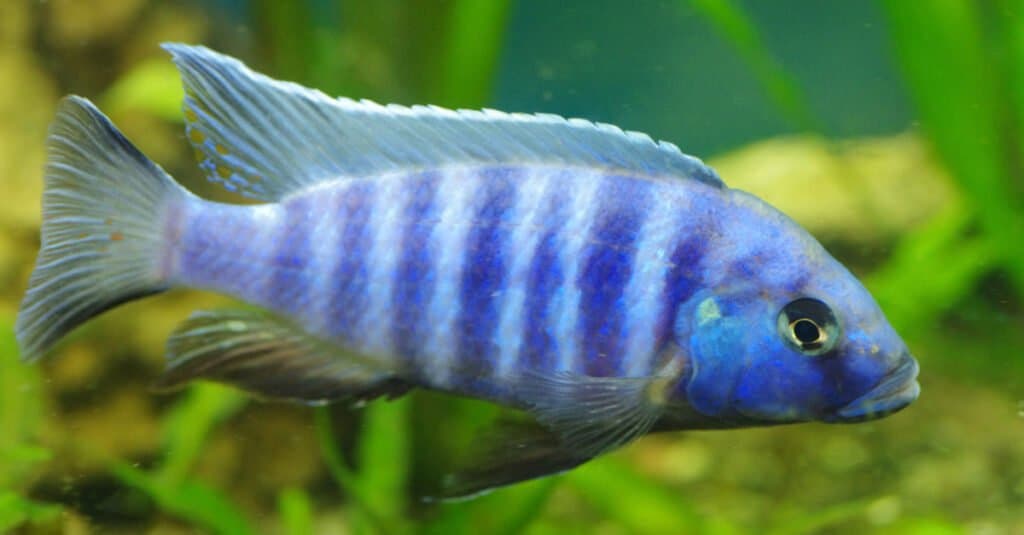
Cichlids come in a range of colors but can be vibrant blues.
©Natalia Sidorova/Shutterstock.com
Cichlids also come in quite a diverse range of colors. Some blue varieties include the Peacock Cichlid, Electric Blue Ahli, Electric Ram Cichlid, and Electric Blue Acara.
Peacock Cichlids come in several colors, including a dark and vivid blue with darker stripes that run vertically along the fish’s body.
Electric Blue Ahlis can be difficult to tell apart from Peacocks, as they have similar coloration and beautiful fin shapes (which swoop larger in the back). Sometimes Electric Blues have less vivid stripes, but it’s often difficult to know for sure unless you’re aware of your fish’s heritage.
Electric Blue Acaras have light blue scales with yellow, green, and orange markings. They’re beautiful, almost pastel-colored Cichlids.
Lastly, Electric Ram Cichlids are a dwarf species. They are blue, with orange and white markings, and red eyes.
Cichlids aren’t small fish, growing up to 15 inches (38.1 centimeters) in length. It’s okay to keep them alone since they are quite territorial! Avoid tank mates like smaller fish, which will likely be eaten.
These fish need a tank that’s at least 125 gallons large.
3. Lake Kutubu Rainbowfish
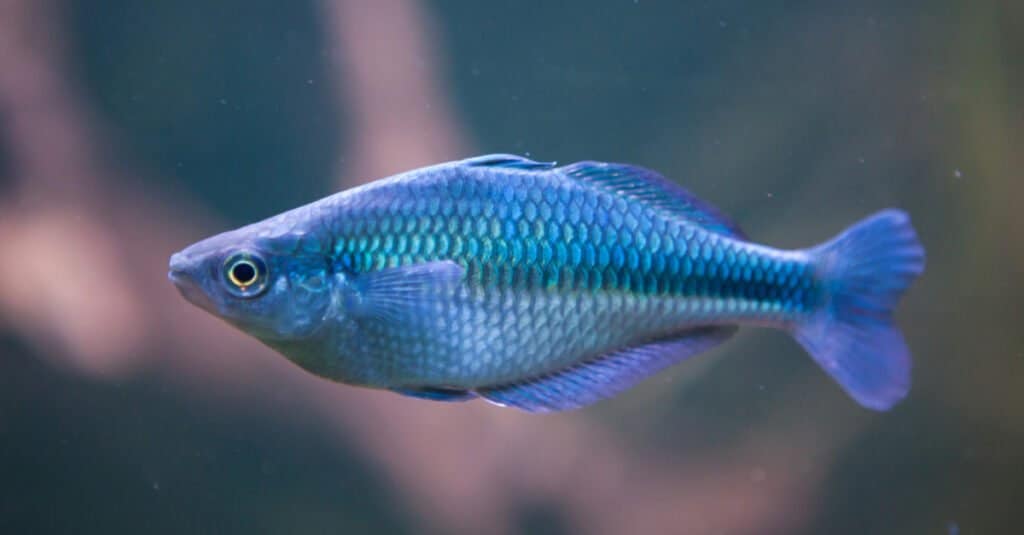
Lake Kutubu rainbowfish might not be as popular as other fish on the list, but they’re a brilliant shade of blue!
©Vladimir Wrangel/Shutterstock.com
Rainbowfish come in a slew of colors, including the blue-green-white gradient of the Lake Kutubu rainbowfish.
They can reach 4.8 inches (12 centimeters) long and are quite social. As schooling fish, they must be kept with at least six of their kind in a single tank.
The smallest tank for rainbowfish is 40 gallons, with more recommended the more fish you adopt.
Watching your rainbowfish swim joyfully and interact with one another is an incredible experience that you’re sure to love!
4. Blue Guppy
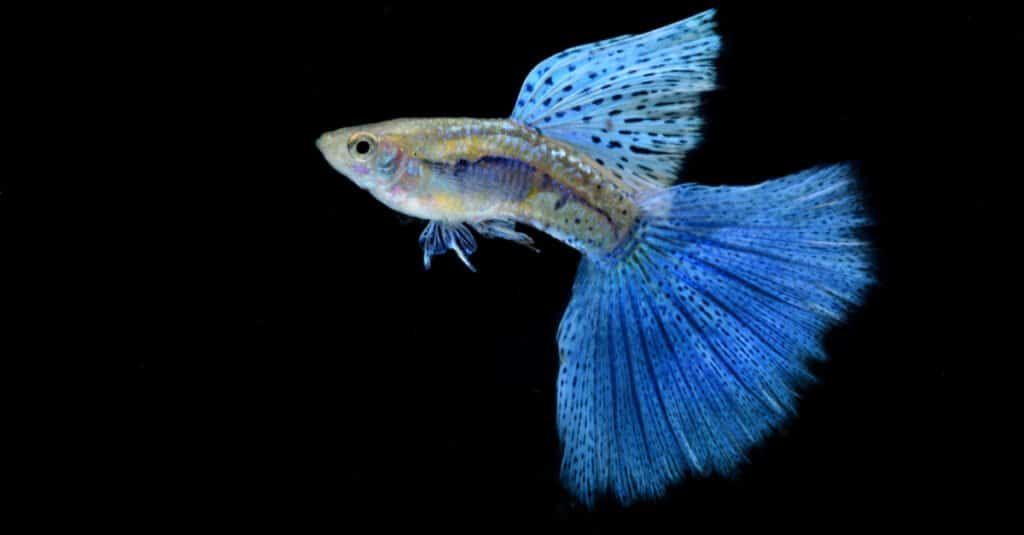
Blue guppies have differently colored bodies but their fins are an incredible blue.
©Nantawat Chotsuwan/Shutterstock.com
Blue guppies tend to have differently colored bodies, particularly in front. They may be silvery, green, or a variety of other colors that complement their flashy, stark blue tail fins.
Guppies are tiny, easy-care fish that grow up to 1.6 inches (4 centimeters) long. They like to live with other guppies and are social, active fish.
Males are known to harass females, so it’s best to keep at least two females for every male guppy in your tank.
We recommend a tank size of 20 gallons or greater, depending on how many guppies you adopt.
5. Dwarf Gourami
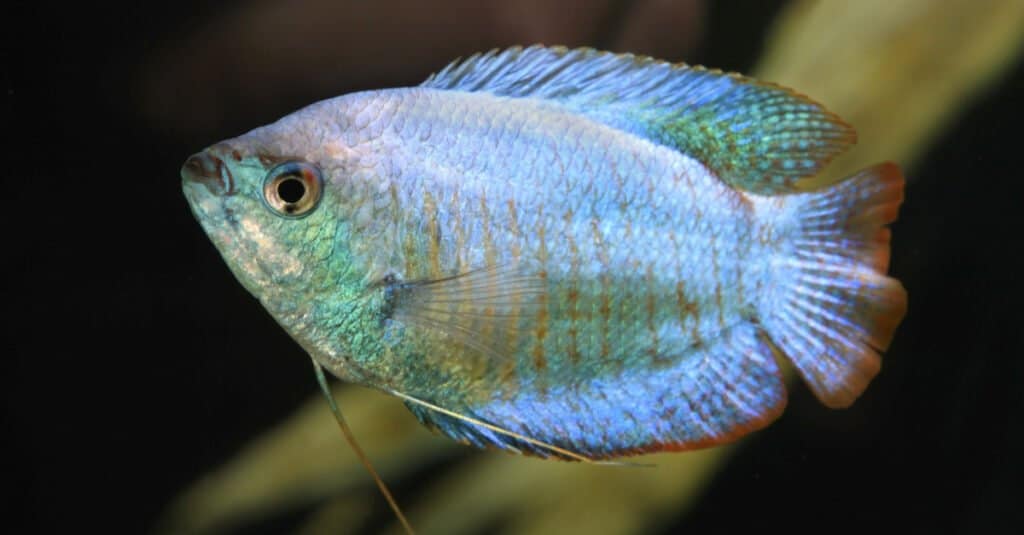
If you’re looking for a powder blue fish, some dwarf gouramis fit that color scheme.
©Steve Bower/Shutterstock.com
Dwarf Gouramis can be bright blue or turquoise with red-orange vertical stripes, red or orange with contrasting blue stripes, or a plain, beautiful blue.
They are incredibly social and love to school, meaning you’ll need at least six of them per tank. They grow to around 3.5 inches (8.9 centimeters) in length, and a minimum tank size of 29 gallons is needed to allow them to be active and happy.
6. Royal Blue Tang

Blue tangs are an intense shade of blue.
©Charlotte Bleijenberg/Shutterstock.com
Royal Blue Tangs are most recognized as the “Dory fish” from the Pixar film Finding Nemo. They are blue with black markings and yellow tails and fins.
Unfortunately, these fish aren’t good for aquariums as they can’t be ethically obtained. They only breed in the wild, never in captivity—meaning that any fish you buy is bound to be captive-caught.
Of course, fish are better off left in the ocean where they can live full, natural lives than they are when caught, sold, and kept in a tank.
However, we couldn’t resist including these iconic fish on this list of blue fish! We can admire them from afar, even if we can’t keep them in our fish tanks.
7. Yellowtail Blue Damselfish

Yellowtail blue damselfish are saltwater fish that can be quite aggressive.
©IanRedding/Shutterstock.com
Damselfish aren’t for beginners. They are saltwater fish, known for their aggressiveness even to humans! However, the right person will love these unique creatures.
Yellowtail Blue Damselfish are just as they sound—small blue fish with yellow tails. Their fins appear almost spiky, particularly the top fins.
They grow to about 2.75 inches (7 centimeters) in length, and you should only keep one damselfish per tank. Their minimum tank size is 20 gallons.
8. Cherub Pygmy Angelfish / Asfur

Cherub angelfish are oval-shaped and have faces that are differently colored than their bodies.
©PAUL ATKINSON/Shutterstock.com
Angelfish are uniquely shaped with triangular bodies and fins. Two beautiful blue varieties are the Cherub Pygmy and the Asfur Angelfish.
Cherub Pygmies tend to have more oval-shaped bodies and are dark blue with bright yellow faces and eyes.
Asfur Angelfish have the more classic, angular angelfish look, with yellow and blue stripes. Their faces tend to be dark in color and their eyes are black.
Angelfish must be kept in schools of six or more in at least an 80-gallon tank. They may show aggression toward other species, and should only be kept with similar-sized or larger fish to prevent them from eating smaller creatures.
9. Neon Blue Dwarf Goby
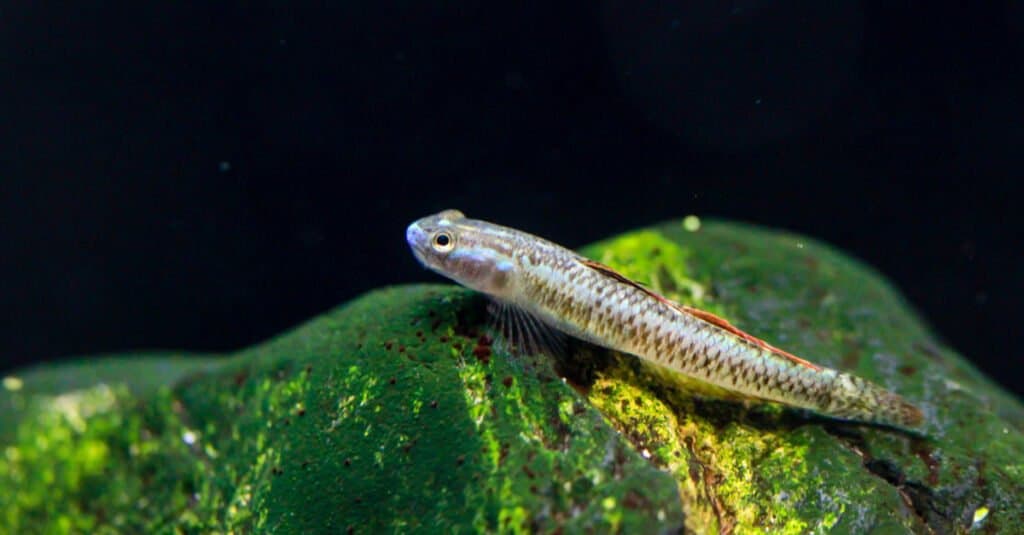
Neon blue dwarf gobies feed on parasites of other fish.
©chonlasub woravichan/Shutterstock.com
These rare fish are long and slender with shiny blue scales. Though Gobies are quite popular, this blue variety is harder to find.
They grow to just 1.5 centimeters, which is a little more than half an inch! These fish help to keep the tank clean by actually cleaning other fish.
They have a symbiotic relationship where the Goby eats parasites, keeping larger fish healthy. Gobies also eat algae.
Gobies do tend to be territorial, however, and should only be kept with peaceful fish of a similar or larger size.
10. Electric Blue Crayfish
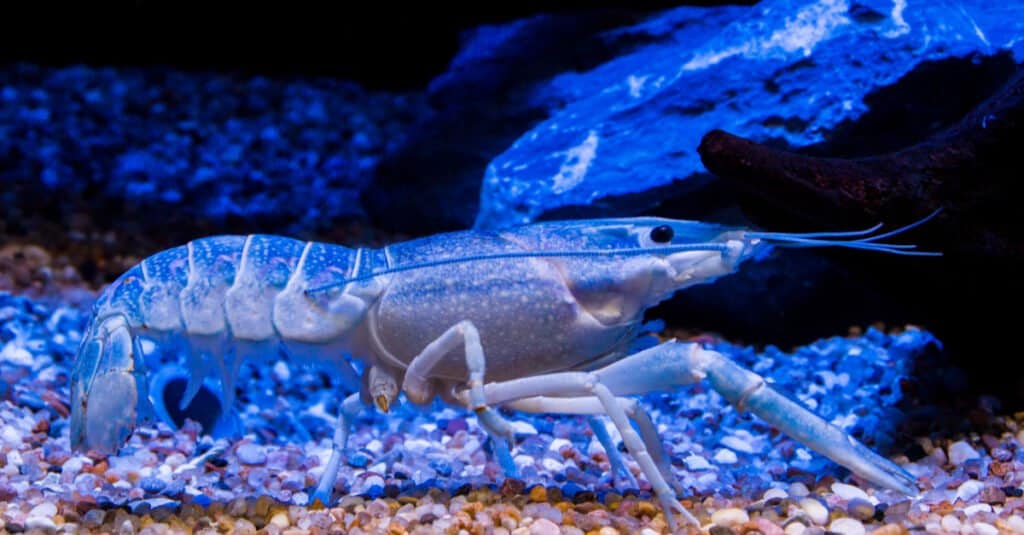
Blue crayfish aren’t fish – but they make an interesting addition to aquariums!
©Danny Ye/Shutterstock.com
Crayfish aren’t truly fish, despite their name. They are freshwater shellfish that we usually imagine as a deep red color.
However, Crayfish can also be bright electric blue!
They are quite territorial and will eat anything they can catch. However, Crayfish are also quite slow. For this reason, they are less likely to catch fast-moving tank mates—though we still recommend against keeping them together due to the risk involved.
Crayfish grow up to 5 inches (12.7 centimeters) and should be kept in a tank that’s at least 30 gallons.
11. Blue Discus

Blue discus can have incredible blue-turquoise coloring.
©Ivan Roth/Shutterstock.com
Blue discus fish are bred in several color varieties, including plain blue and blue-turquoise with dark or red, almost maze-like patterns.
Discuses grow to around 8.6 inches (21.8 centimeters) long, so they’re not small fish! They are quite thin though, with not much depth to them physically.
These social fish must live in groups of six or more, and be kept in at least a 60-gallon tank.
12. Shrimp

Blue shrimp can be a welcome addition to small tanks at home.
©Shrimplake/Shutterstock.com
While shrimps aren’t actually fish, we couldn’t leave them off this list! They’re a perfect addition to most aquariums, especially in the blue velvet color.
These shrimps are an adorable bright blue. They can be kept in groups in a single tank, or together with fish to create a colorful tank.
The minimum size for shrimp is 5 gallons, though you should go bigger if keeping many shrimp or any tank mates.
Additionally, be sure to choose docile, small tank mates who won’t eat your shrimp when given the chance!
Summary of 12 Types of Blue Fish
| Rank | Blue Fish |
|---|---|
| 1 | Betta |
| 2 | Cichlid |
| 3 | Lake Kutubu Rainbowfish |
| 4 | Blue Guppy |
| 5 | Dwarf Gourami |
| 6 | Royal Blue Tang |
| 7 | Yellowtail Blue Damselfish |
| 8 | Cherub Pygmy Angelfish / Asfur |
| 9 | Neon Blue Dwarf Goby |
| 10 | Electric Blue Crayfish |
| 11 | Blue Discus |
| 12 | Shrimp |
What is the Rarest Blue Fish?
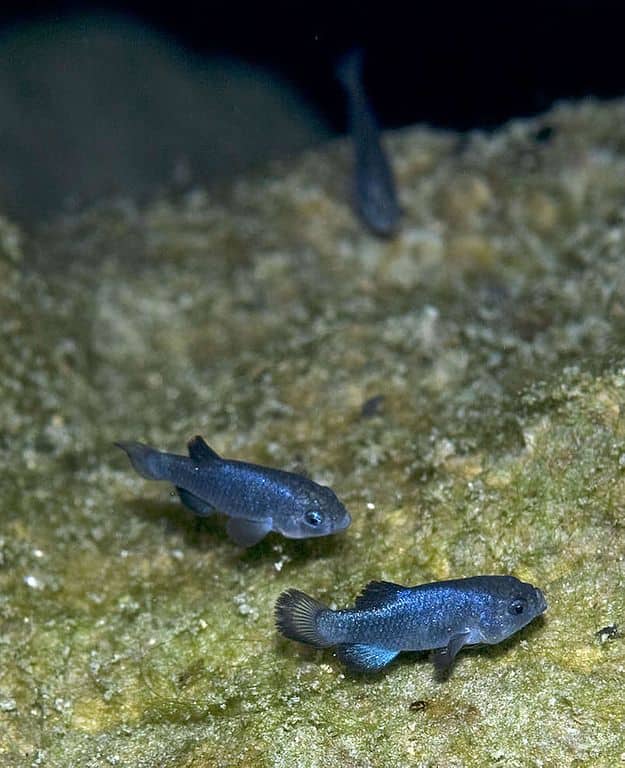
Devil’s Hole Pupfish have adapted to the extreme conditions of their habitat, where water temperatures can reach 91 degrees Fahrenheit.
©Olin Feuerbacher / USFWS / public domain – License
The ocean is believed to contain more than 32,000 species of fish, although it is likely that not all species have been discovered, which would add to this number significantly. Of these, there are a vast amount of colorful fish, from the bluefin notho killifish (Nothobranchius rachovii) to the Queen angelfish (Holacanthus ciliaris). Some are more prevalent than others and the rarest blue fish is thought to be the devil’s hole pupfish (Cyprinodon diabolis).
This little blue fish is a critically endangered species that is only found in one location, Devil’s Hole, Nevada, which is a water-filled cavern. It is a close relative of the Death Valley pupfish (Cyprinodon salinus), found only in Death Valley National Park, and the Amargosa pupfish (Cyprinodon nevadensis), endemic to areas of the Mojave Desert in California and Nevada. The devil’s hole pupfish is small, reaching lengths of up to 1.2 inches, and colors vary between age and sex – the males exhibit a bright, metallic blue while juveniles and females are closer to yellow.
Populations of this pupfish are counted two times per year, one in the summer and one in the fall, and as of the fall of 2022, their numbers were only 263 observed fish, although some reports also have it as low as 35 fish. It has been listed as endangered since 1967.
The photo featured at the top of this post is © Nantawat Chotsuwan/Shutterstock.com
Thank you for reading! Have some feedback for us? Contact the AZ Animals editorial team.



